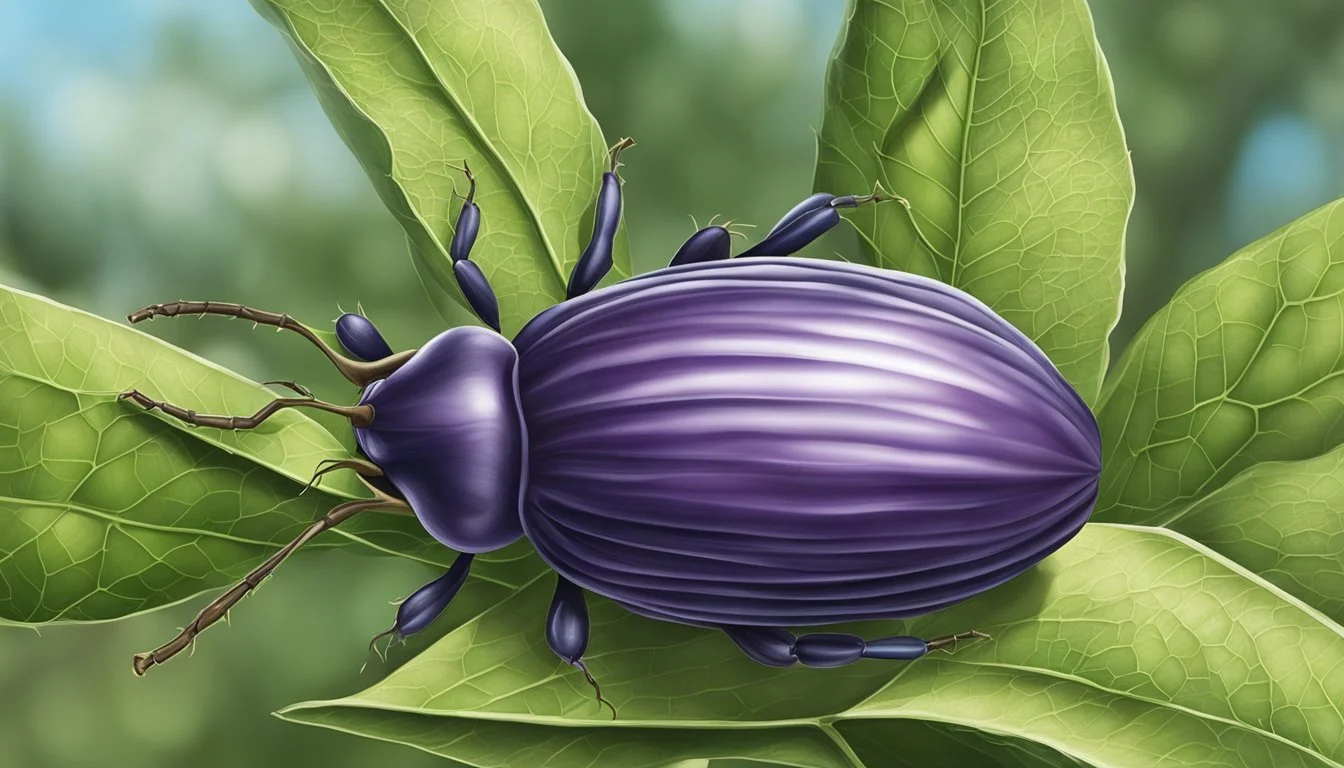Protecting Crops from Plum Curculio
Effective Strategies for Orchard Management
Plum curculio, scientifically known as Conotrachelus nenuphar, is a notorious insect pest that threatens various stone fruit crops within orchards across North America. As a small weevil typically found attacking fruits like peaches, plums, and cherries (how long do cherries last?), its lifecycle is often closely intertwined with the development of the fruit, making it a challenging adversary for growers. Effective management of this pest is critical to ensure the health and productivity of fruit trees, as both adult weevils and their larvae can cause significant damage. Adults are known for their characteristic feeding and oviposition marks on young fruit, while the larvae burrow inside, leading to premature fruit drop and potential crop losses.
Pest management strategies for combating plum curculio involve a combination of well-timed insecticide applications and non-chemical measures. Understanding the biology and behavior of the pest is key; growers must monitor weather trends and phenological stages of their crops to make informed decisions on control measures. The integration of chemical sprays with methods such as orchard sanitation and trapping can enhance the effectiveness of control programs.
In orchards, the timing of interventions is crucial, as it is typically synchronized with specific stages of fruit development to maximize impact. For instance, applications during the petal fall phase can help mitigate adult weevil infestations before they lay eggs. Adhering to carefully planned management strategies can significantly reduce the plum curculio populations and safeguard the yield and quality of the harvest.
Biology and Life Cycle
Understanding the biology and life cycle of the Plum Curculio is essential for effective management and protection of fruit crops. This section will focus on identifying these insects, their development stages, and the key timing of their life cycle to better safeguard fruit production.
Identifying Plum Curculio
Plum Curculio, Conotrachelus nenuphar, are small beetles identifiable by their characteristic snout which is nearly one-third the length of their bodies. They are typically gray to brown in color, with rounded wing covers that have four humps and possess grayish-white patches.
Development Stages
The development stages of Plum Curculio include:
Eggs: Laid by adult females in the spring, often in crescent-shaped cuts made on fruit surfaces.
Larva: After hatching, the larvae feed within the fruit, causing significant damage.
Pupa: Larvae eventually exit the fruit and pupate in the soil.
Adult Beetles: After pupating, new adult beetles emerge and may feed on fruit before overwintering, ready for the next season.
Life Cycle Timings
The life cycle of Plum Curculio varies:
North America: Predominantly a single generation per year (univoltine), especially in the northern regions, including Canada and extending to the Rocky Mountains.
Southeast: In warmer climates such as the Southeastern United States, a multivoltine strain exists with two generations annually.
Seasonal Timings: Adults overwinter in wooded areas or orchard edges, emerging in early spring. Key developmental milestones such as egg-laying typically coincide with the "petal fall" and "shuck split" stages of fruit trees in the spring.
Host Trees and Damage
Plum curculio is a key pest of fruit trees, inflicting damage through adult feeding, egg laying, and larval consumption of fruit tissue. Understanding the host trees and identifying the signs of damage are essential to protect and manage the health of these trees.
Common Hosts
Plum curculio has an affinity for various Rosaceae family members, preferring a range of fruit trees. They are significant pests of:
Apple
Pear
Peach
Plum, including wild plum
Cherry
Nectarine
Apricot
These trees, especially when grown commercially, can suffer considerable damage if preventive measures are not implemented.
Recognizing Damage
The signs of plum curculio damage can be categorized based on the insect's life stage responsible for the harm:
Adult Feeding and Egg Laying:
Scarring: Look for crescent-shaped marks or oviposition scars on young fruit from adults that have cut through the skin to lay eggs.
Surface Blemishes: Adult plum curculio may cause superficial damage by feeding on blossoms, buds, and developing fruit.
Larval Damage:
Tunneling: Larvae create C-shaped tunnels through the fruit after hatching, leading to further degradation.
Fruit Drop: Infested fruit often prematurely falls from the tree due to larval activity disrupting the fruit growth, rendering it inedible.
The damage from plum curculio can be dire if left unmanaged, with infestations potentially causing significant yield loss and economic harm to fruit production.
Monitoring and Detection
Effective monitoring and detection are essential for making timely management decisions in integrated pest management (IPM) strategies against plum curculio. Orchards can suffer significant fruit drop due to these pests, and early detection can minimize damage.
Visual Inspection
In orchards, they conduct regular visual inspections as a foundational monitoring technique. Inspectors look for the distinctive crescent-shaped oviposition scars on fruits which indicate plum curculio activity. During these inspections, they also check for fallen fruit, which can be a sign of larval presence inside.
Trap Deployment
Trap deployment serves as a direct method for capturing adult beetles. Traps may include baited systems or sheets placed under trees. By deploying these traps around the perimeter of the orchard, they can gauge plum curculio populations and determine the need for intervention.
Population Assessment
For population assessment, the use of jarring techniques can effectively dislodge adult beetles from trees for counting. By shaking branches over sheets and collecting the grubs that fall, they can assess the adult population density. This information guides orchard managers in their IPM strategies, including when to apply controls and the intensity required.
Control Strategies
Effective management of plum curculio involves a combination of strategies targeted at disrupting the life cycle of the pest and protecting the fruit yield. Growers can employ a range of techniques, from cultural methods to more direct interventions, to safeguard their orchards.
Cultural Practices
Key to cultural control is sanitation. Growers should regularly clear their orchards of debris and fallen fruit, which can serve as overwintering sites for plum curculio. Timely removal and disposing of infested fruits help to reduce the number of pests that can breed and affect the next season's crop.
Biological Control
Biological control in orchards introduces beneficial insects and fungi that are natural predators or parasites of plum curculio. It is a sustainable approach focusing on long-term suppression of the pest population and should be part of an integrated pest management program.
Chemical Control
When chemical control is necessary, pesticides can be applied at critical times, such as after petal fall and before fruit ripening, to target the adult beetle. Kaolin clay is a non-toxic option that can deter plum curculio from laying eggs. It should be noted that all chemical control methods must be part of a well-planned strategy to minimize resistance and safeguard beneficial species.
Preventative Measures
Protecting crops from plum curculio involves a series of targeted actions within an Integrated Pest Management (IPM) framework. Emphasizing the importance of orchard hygiene, meticulous tree care, and vigilant monitoring can lay a strong foundation for reducing infestations.
Sanitation
Thorough sanitation practices are vital in limiting plum curculio populations. They should remove fallen fruit and debris from beneath trees regularly, as these materials provide shelter for larvae and adult beetles. Disposing of infested fruits and pruning waste away from orchard grounds helps disrupt the life cycle of the pest and prevents re-infestation.
Tree Maintenance
Proper tree maintenance contributes to a less hospitable environment for plum curculio. They must maintain the foliage and branches to improve air circulation and sunlight penetration, which are conditions less favorable to the pest. Pruning also facilitates easier inspection of the trees for signs of plum curculio activity.
Quarantine and Inspection
Routine quarantine and inspection procedures are crucial for early detection and management of plum curculio. They should inspect incoming plant material to prevent introducing new pests into established orchards. Regularly inspecting trees for signs of damage, such as crescent-shaped cuts on young fruit, can lead to prompt and more effective pest control measures.
Future Research and Perspectives
As the battle against the plum curculio continues, key areas of future research involve developing more sustainable control methods and enhancing existing integrated pest management (IPM) strategies. Research into behavioral ecology is promising, as understanding the pest's life cycle and mating habits can lead to more effective timing of control measures.
Biological Control: Investigations into natural predators and the application of entomopathogenic nematodes present a significant area of research for reducing plum curculio populations without reliance on chemical insecticides.
Genetic Studies: There is a pressing need for genetic studies to identify potential weaknesses or traits in plum curculio that can be targeted through biological or other innovative control methods.
Innovative Trapping Techniques: Development of more efficient trapping systems, possibly using pheromones or attractants, might provide better monitoring and control options.
Host Plant Resistance: Exploring the resistance traits of certain fruit varieties can inform breeding programs aimed at developing crops less susceptible to plum curculio damage.
In line with disseminating research findings, there's also a valuable opportunity in the production of an ebook or comprehensive digital guide, which would aggregate current knowledge and scientific advancements. This resource could serve as a timely reference for researchers, agricultural extension workers, and farmers.
Researchers also emphasize the importance of extensive field trials to evaluate new control tactics under different environmental conditions and across various crop species. As they work to identify environmentally friendly and economically viable solutions, there is a collective hope in the scientific community that these efforts will lead to a future where fruit crop losses to plum curculio are greatly minimized.
Frequently Asked Questions
This section provides clear answers to common inquiries about managing plum curculio, a pest that affects a variety of fruit trees. The answers are grounded in reliable methods and practices for both detection and control.
What measures are effective for organic control of plum curculio?
Organic control methods for plum curculio include jarring the insects from trees and disposing of them, as they are most active in the early morning. Additionally, maintaining orchard sanitation by removing fallen fruits can reduce larval survival.
Which insecticides are known to be effective against plum curculio?
Effective insecticides against plum curculio include phosmet and carbaryl. It's crucial to follow the label instructions precisely when applying any insecticide.
How can plum curculio infestation be detected and monitored?
Infestation by plum curculio can be detected through close examination of fruit for the distinctive crescent-shaped cuts caused by adult feeding and egg-laying. Monitoring can also involve checking for larvae within the fruit.
What types of traps can be used to combat plum curculio?
Various traps, such as pyramid and circle traps baited with plum curculio lures, can be employed to monitor and reduce populations of plum curculio in orchards.
What does plum curculio damage look like on fruit crops?
Damage caused by plum curculio appears as crescent-shaped cuts on the surface of the fruit where females insert eggs, and as larval entry holes. Infested fruits often drop prematurely or develop larval tunnels inside.
Are there any natural predators of plum curculio that can aid in its control?
Natural predators of plum curculio do exist and include certain species of ants, spiders, and ground beetles that can feed on the eggs and larvae, thereby helping to control the population.




